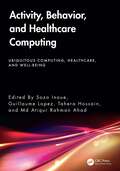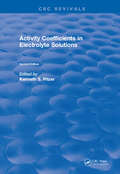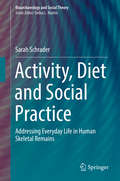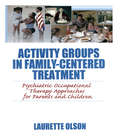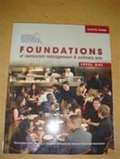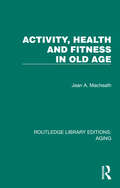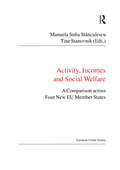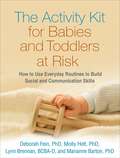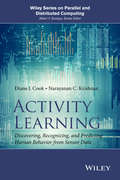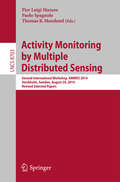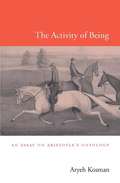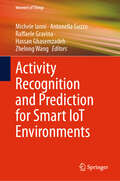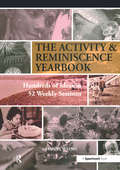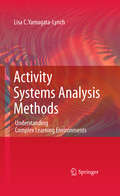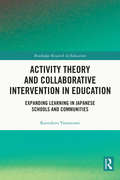- Table View
- List View
Activity, Behavior, and Healthcare Computing (Ubiquitous Computing, Healthcare and Well-being)
by Sozo Inoue Guillaume Lopez Tahera Hossain Rahman Ahad, Md AtiqurActivity, Behavior, and Healthcare Computing relates to the fields of vision and sensor-based human action or activity and behavior analysis and recognition. As well as a series of methodologies, the book includes original methods, exploration of new applications, excellent survey papers, presentations on relevant datasets, challenging applications, ideas and future scopes with guidelines. Featuring contributions from top experts and top research groups globally related to this domain, the book covers action recognition, action understanding, gait analysis, gesture recognition, behavior analysis, emotion and affective computing, healthcare, dementia, nursing, Parkinson’s disease, and related areas. It addresses various challenges and aspects of human activity recognition – both in sensor-based and vision-based domains. This is a unique edited book covering both domains in the field of activity and behavior.
Activity Book 1, Comprehension and Skill Work, Units 1-7
by Sopris West Educational ServicesA Level One reading comprehension workbook.
Activity Book, Grade 4, Unit 1: Personal Narratives
by Core Knowledge FoundationNIMAC-sourced textbook
Activity Book, Grade 4, Unit 7: American Revolution
by Core Knowledge FoundationNIMAC-sourced textbook
Activity Book, Grade 5, Unit 1: Personal Narratives
by Core Knowledge FoundationNIMAC-sourced textbook
Activity Book, Grade 5, Unit 2: Early American Civilizations
by Core Knowledge FoundationNIMAC-sourced textbook
Activity Coefficients in Electrolyte Solutions
by Kenneth S. PitzerThis book was first published in 1991. It considers the concepts and theories relating to mostly aqueous systems of activity coefficients.
Activity, Diet and Social Practice: Addressing Everyday Life in Human Skeletal Remains (Bioarchaeology and Social Theory)
by Sarah SchraderDay-to-day activities are important in the development of social identities, the establishment of social standing, and the communal understanding of societal rules. This perspective is broadly referred to as practice theory and relates to the power of an overarching social structure and the individual actors that exist within it. Practice theory has made an important contribution to anthropological and archaeological research as these fields are particularly interested in daily life and the importance of these actions.This volume argues that practice theory can also be used in a bioarchaeological context through the examination of human skeletal remains and the archaeological context in which they were excavated. Bioarchaeology offers a unique perspective on these day-to-day experiences—skeletal tissue is constantly undergoing a process of change and, as a living biological system, it can adapt to external forces. Furthermore, bioarchaeological studies are multi-scalar and can examine individuals, groups, or entire populations.Using osteological indicators of activity patterns (entheseal changes, osteoarthritis) and dietary isotopes (carbon, nitrogen) as examples, this book addresses patterns of everyday life in the ancient past. Physical activities and food consumption are actions that are carried out on a daily basis. While bioarchaeology does not have the ability to recreate specific day-to-day activities, we can assess broad trends in everyday life. The volume illustrates these points using examples from the Ancient Nile Valley. Through the examination of over 800 Egyptian and Nubian individuals from five different archaeological sites, the research addresses patterns of everyday life as they relate to social inequality, agency, and practice. Beyond osteological indicators of activity and dietary patterns, this book also discusses additional methods that can be pursed to draw attention to daily life. Lastly, this book also highlights the applicability of and potential contribution that practice theory can make to this area of research.
Activity Groups in Family-Centered Treatment: Psychiatric Occupational Therapy Approaches for Parents and Children
by Laurette OlsonGet the tools for practical family-based interventions for children or adolescents with mental illness Providing parent-child occupation-based interventions can be one of the most important therapeutic services offered to children or parents with mental illness and their families. Activity Groups in Family-Centered Treatment: Psychiatric Occupational Therapy Approaches for Parents and Children provides useful in depth "how to" strategies into the processes of providing family occupation-based group intervention when a child has a mental illness. Occupational therapists working with children or parents with mental illness can learn valuable practical interventions to apply in their own clinical work.Cherished activities that strengthen parent-child bonds are many times lacking in families that include a child or parent with mental illness. Activity Groups in Family-Centered Treatment describes valuable parent-child occupation-based interventions with detailed examples of how they have been provided in therapy. This text provides an overview of the literature related to providing family-based psychiatric OT treatment for children and their families, a framework for providing services, rich descriptions of a parent-child activity group, a parent-adolescent activity group, and case studies of inpatient and home-based occupation based interventions.Topics in Activity Groups in Family-Centered Treatment include: an overview of theory and research literature on the nature of the interaction between parents and children with emotional disorders detailed case studies of family challenges with mental illness a framework for parent-child activity groups a qualitative study of a parent-child activity group analysis of the barriers that can arise in a parent-child activity group clinical experiences leading a parent-adolescent activity group analysis of the influences of culture within a parent-child activity group a case study of the intervention for a depressed mother and her family issues between parents and professionals when children are psychiatrically hospitalizedActivity Groups in Family-Centered Treatment provides occupational therapists and other professionals who lead parent-child groups or who work with families that include a child or parent with mental illness with integral tools to effectively treat their clients.
Activity Guide For Foundations Of Restaurant Management And Culinary Arts: Level 1
by National Restaurant Association Staff<P>Industry-driven curriculum that launches students into their restaurant and foodservice career<P>! Curriculum of the ProStart(r) program offered by the National Restaurant Association.<P> The National Restaurant Association and Pearson have partnered to bring educators the most comprehensive curriculum developed by industry and academic experts.
Activity, Health and Fitness in Old Age (Routledge Library Editions: Aging)
by Jean A. MacheathPhysical activity is a key element in maintaining the independence and quality of life of older people. It is vitally important that those in the caring professions working with the elderly are aware of the capabilities and expectations of older people in this respect.
Activity, Incomes and Social Welfare: A Comparison across Four New EU Member States (Public Policy and Social Welfare)
by Manuela Sofia StanculescuThis book describes and quantifies the major socioeconomic changes that have occurred in four new member states of the EU (Slovenia, Hungary, Romania and Bulgaria) since the early 1990s. The period covered was a particularly turbulent one, not only because of the transition process which was well underway but becase of the stablization packages and other economic, monetary and social policy measures, which have had a strong impact at individual and household levels. While previous comparable studies have been carried out, they cover the period only to the mid 1990s, thus this book contains unique and very valuable statistical and micro data. Within the broad framework of socioeconomic change, a number of topics are explored in greater detail. These include changes in activity, occupational status and educational attainment, household income sources and income inequality, and risk of income poverty. The analysis is based on household budget surveys and complemented with other statistical sources, enabling a coherent analysis of the impact of large changes in social policy at household level. The country chapters are all based on common methodological guidelines enabling comparisons to be drawn. This will be an invaluable book for researchers in comparative social policy, poverty and social stratification and economic sociology, and for specialists on Central and Eastern Europe.
The Activity Kit for Babies and Toddlers at Risk
by Molly Helt Deborah Fein Lynn Brennan Marianne BartonSuspecting that your baby or toddler may have autism spectrum disorder or another developmental delay can be scary and overwhelming. But there is a lot you can do to help, even while waiting for an evaluation or early intervention. With the right tools, everyday tasks can be terrific opportunities for building critical social and communication skills. Start at the kitchen table, bathtub, or shopping cart! In this easy-to-navigate guide, leading experts present more than 100 games and activities designed to support development in children from birth to age 3. Your child's daily routines are transformed into learning opportunities that promote crucial abilities, like how to imitate others or use simple hand gestures to convey wants and needs. As a parent, you are the most important person in your child's life. Now you can be the best teacher, too.
Activity Learning
by Narayanan C. Krishnan Diane J. CookDefines the notion of an activity model learned from sensor data and presents key algorithms that form the core of the field Activity Learning: Discovering, Recognizing and Predicting Human Behavior from Sensor Data provides an in-depth look at computational approaches to activity learning from sensor data. Each chapter is constructed to provide practical, step-by-step information on how to analyze and process sensor data. The book discusses techniques for activity learning that include the following: Discovering activity patterns that emerge from behavior-based sensor data Recognizing occurrences of predefined or discovered activities in real time Predicting the occurrences of activities The techniques covered can be applied to numerous fields, including security, telecommunications, healthcare, smart grids, and home automation. An online companion site enables readers to experiment with the techniques described in the book, and to adapt or enhance the techniques for their own use.With an emphasis on computational approaches, Activity Learning: Discovering, Recognizing, and Predicting Human Behavior from Sensor Data provides graduate students and researchers with an algorithmic perspective to activity learning.
Activity Monitoring by Multiple Distributed Sensing: Second International Workshop, AMMDS 2014, Stockholm, Sweden, August 24, 2014, Revised Selected Papers (Lecture Notes in Computer Science #8703)
by Thomas B. Moeslund Pier Luigi Mazzeo Paolo SpagnoloThis book constitutes the thoroughly refereed post-conference proceedings of the Second International Workshop on Activity Monitoring by Multiple Distributed Sensing, AMMDS 2014, held in Stockholm, Sweden, in August 2014, as a satellite event of ICPR 2014, the 22nd International Conference on Pattern Recognition. The 9 revised full papers included in the volume investigate the challenges that arise when distributed sensor networks are used to track, monitor, and understand the activity, intent, and motives of human beings. Application areas include human-computer interaction, user interface design, robot learning, and surveillance.
The Activity of Being
by Aryeh KosmanUnderstanding “what something is” has long occupied philosophers, and no Western thinker has had more influence on the nature of being than Aristotle. Focusing on a reinterpretation of the concept of energeia as “activity,” Aryeh Kosman reexamines Aristotle’s ontology and some of our most basic assumptions about the great philosopher’s thought.
Activity Recognition and Prediction for Smart IoT Environments (Internet of Things)
by Raffaele Gravina Zhelong Wang Michele Ianni Antonella Guzzo Hassan GhasemzadehThis book provides the latest developments in activity recognition and prediction, with particular focus on the Internet of Things. The book covers advanced research and state of the art of activity prediction and its practical application in different IoT related contexts, ranging from industrial to scientific, from business to daily living, from education to government and so on. New algorithms, architectures, and methodologies are proposed, as well as solutions to existing challenges with a focus on security, privacy, and safety. The book is relevant to researchers, academics, professionals and students.
Activity & Reminiscence Handbook: Hundreds of Ideas in 52 Weekly Sessions
by Danny WalshThis comprehensive guide provides a bumper book of original resource material for reminiscence and activities with older people for a whole year! Containing 52 sections of ideas and resource materials for each week of the year, this is an invaluable resource for activity organisers and group leaders in residential, day care and hospitals, and for anyone working with older people. There is a theme for each week, eg. Animals and pets, with corresponding ideas for social events, reminiscence, exercises and games, quizzes, art and crafts, as well as 'this week in history', good ideas', 'discussion topics', 'homework' and the option to personalise the week by recording local anniversaries and events alongside personal landmarks and details. The ideas are easy to use and are relevant for both groups and individuals, including those with mental health and cognitive problems. Some activities require some physical effort, others mental effort, but they are all adaptable to be fun and achievable. This book also includes an introduction to the nature and value of reminiscence and activities, and guidelines on 'how to do it'. Written by the author of "Groupwork Activities", this comprehensive resource provides hundreds of activity and reminiscence ideas - a fantastic resource.
Activity Systems Analysis Methods: Understanding Complex Learning Environments
by Lisa C. Yamagata-LynchIn the last two decades, there has been growing interest in pursuing theoretical paradigms that capture complex learning situations. Cultural Historical Activity Theory (CHAT) is one of several theoretical frameworks that became very popular among educational researchers because it conceptualizes individuals and their environment as a holistic unit of analysis. It assumes a non-dualistic ontology and acknowledges the complexities involved in human activity in natural settings. Recently, reputable journals such as the American Psychologist, Educational Psychologist, and Educational Researcher that are targeted for a wide-range of audience have included articles on CHAT. In many of such articles, CHAT has been referred to as social constructivism, sociocultural theory, or activity theory. Activity systems analysis is one of the popular methods among CHAT researchers for mapping complex human interactions from qualitative data. However, understanding the methods involved in activity systems analysis is a challenging task for many researchers. This difficulty derives from several reasons. First the original texts of CHAT are in Russian and there have been numerous authors who report on the difficulties of reconciling translation problems of the works of original authors' such as Vygotsky and Leontiev. Second, in North America activity systems analysis has deviated from the Russian scholars' intentions and Engeström's original work using the triangle model to identify tensions to overcome and bring about sociopolitical change in participant practices. Third, to this date there are numerous publications on the theoretical background of activity theory and studies reporting the results of using activity systems analysis for unpacking qualitative data sets, but there have been no methodological publications on how researchers engage in activity systems analysis. Thus, there is a dearth of literature in both book and journal publications that guide researchers on the methodological issues involving activity systems analysis.
Activity Theory and Collaborative Intervention in Education: Expanding Learning in Japanese Schools and Communities (Routledge Research in Education)
by Katsuhiro YamazumiBy applying cultural-historical activity theory and expansive learning theory to educational research, this volume illuminates new forms of educational activities as collaborative interventions in schools and communities where learners and practitioners generate expansive learning so that they can collectively transform their activities and expand their agency for themselves. It covers four cases of activity-theoretical formative intervention studies conducted in Japan, which are related to: fostering children’s expansive learning in classroom lessons; teachers as collaborative change agents in redesigning schools; expanding the school activity from below; and emerging knotworking agency in community-based disaster prevention learning. This book employs activity theory as a general theoretical framework of human learning and development to connect focal data from empirical and interventional studies on real human learning in specific educational settings in Japan. In this way, the book illustrates how the general theoretical framework could be used to understand a specific socio-cultural milieu, that is, the Japanese context. It also shows the universal relevance of the Japanese context of educational activity on broader international research, analyzing concrete empirical data from specific settings in Japan. In conclusion this book creates new understanding and develops a cohesive framework of the agentic and hybrid nature of educational activities as collaborative interventions in the expansion of learning.
